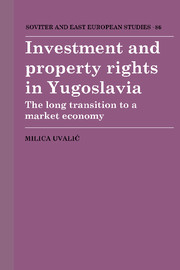Book contents
- Frontmatter
- Contents
- List of figures
- List of tables
- Preface and acknowledgements
- Introduction
- Part I The institutional and theoretical framework
- Part II Empirical evidence on the nature of the Yugoslav system
- 5 Yugoslav investment and savings performance
- 6 The determinants of investment in Yugoslavia
- 7 Econometric tests of Yugoslav investment behaviour
- Part III Pressure for more radical reforms in Yugoslavia
- Notes
- List of references
- Index
- Series list
5 - Yugoslav investment and savings performance
Published online by Cambridge University Press: 11 January 2010
- Frontmatter
- Contents
- List of figures
- List of tables
- Preface and acknowledgements
- Introduction
- Part I The institutional and theoretical framework
- Part II Empirical evidence on the nature of the Yugoslav system
- 5 Yugoslav investment and savings performance
- 6 The determinants of investment in Yugoslavia
- 7 Econometric tests of Yugoslav investment behaviour
- Part III Pressure for more radical reforms in Yugoslavia
- Notes
- List of references
- Index
- Series list
Summary
The theoretical framework for understanding the investment behaviour of the Yugoslav firm discussed in part I will now be confronted with empirical evidence from Yugoslavia. The period examined is primarily post-1965, for it is as a result of the reforms of the mid-1960s that the investment sphere was extensively decentralized, giving more autonomy to enterprises. (For the sake of comparison, however, the first half of the 1960s is also briefly considered.)
Investment and savings at the aggregate level
According to official Yugoslav statistics, the Yugoslav economy achieved high investment and savings rates during most of the period under examination. In the years immediately following the 1965 reform, however, some moderation of these rates was registered. In comparison with the 1961–5 period, in 1966–70 the relative share of gross investment in GMP declined from 43 per cent to 38 per cent, of which investment in fixed assets declined from 32.2 per cent to 30.6 per cent (see table 5A.1 in the appendix to this chapter). After this initial decline, during the 1970s investment shares in GMP showed a steadily increasing trend, rising to 40.6 per cent and then to 43.3 per cent of GMP in the two five-year periods of the 1970s, with investment in fixed assets accounting for 30 per cent and 37 per cent of GMP respectively.
The level of investment reached at the end of the 1970s was well above the domestic savings potential of the Yugoslav economy. The failure to control the overall investment effort, especially in the second half of the 1970s, had important implications for macroeconomic stability and balance of payments performance.
- Type
- Chapter
- Information
- Investment and Property Rights in YugoslaviaThe Long Transition to a Market Economy, pp. 69 - 96Publisher: Cambridge University PressPrint publication year: 1992



